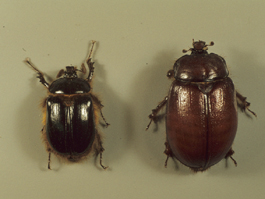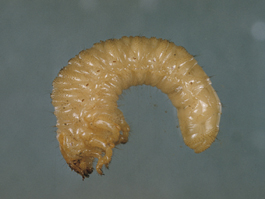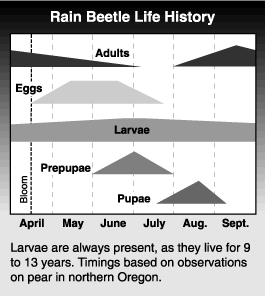by Helmut Riedl and Elizabeth H. Beers, revised May 2007
(Coleoptera: Pleocomidae)
Pleocoma crinita Linsley
Pleocoma minor Linsley
Pleocoma oregonensis Leach

Rain beetles are a small group of beetles in the genus Pleocoma. They are closely related to the scarabs, but are currently placed in a separate family. These beetles are found only in western North America. The above species have been found in fruit growing areas in the Pacific Northwest. Adults are called rain beetles because they usually fly after fall rains. The larvae are called white grubs. They feed on roots of forest and orchard trees.
Root damage to fruit trees in California by Pleocoma larvae was reported in the 1920s and 1930s. An orchard survey in the Mid-Columbia area of northern Oregon and southern Washington in 1953 found that rain beetle grubs seriously damaged roots on bearing trees and made it difficult to establish new plantings. Populations of five or more larvae per square foot have been found in some orchards in northwest Oregon. Affected trees go into slow decline.
Hosts
Pleocoma larvae will attack most deciduous fruit trees. Root damage by rain beetle larvae has been reported in apple, pear and other orchard trees in California, and in apple, pear and cherry trees in the Mid-Columbia area. Native hosts in the Mid-Columbia area include Douglas fir, Ponderosa pine, white fir, white oak, Oregon maple, vine maple and black cottonwood. P. oregonensis also feeds on sagebrush.
Life stages
Egg
The egg is white with a yellowish tinge and has a smooth, dull surface. It is oval and is usually about 1/6 inch (4.5mm) long.

Larva
The larva is grub-like with a curved, whitish body and pale yellow-brown head. Mature larvae are from 1-3/4 to 2-1/4 inches (45 to 55 cm) long. In the prepupal stage they are creamy white, flaccid and immobile.
Pupa
The female pupa is white and measures from 1-1/2 to 1-3/4 inches (35 to 45 mm) long, depending on the species. The male pupa is generally smaller.
Adult
The adult is similar in appearance to scarab beetles, with strong legs for digging. It is dark or reddish brown and hairy. Its antennae have oval clubs at the end made up of several lamellae, or plate-like structures. The male’s antennae have longer lamellae than the female’s. The female P. oregonensis is about 7/8 to 1 inch (22 to 25 mm) long. Female P. crinita and P. minor are about 5/8 inch (15 mm) long. Females are larger than the males, and are flightless. Neither sex feeds in the adult stage.
Life history
 Rain beetles appear in the field at different times according to species. Generally, pupae transform to adults in August and September when beetles leave their pupal cells and burrow to the surface. Adults can live for many months but do not feed. Only male beetles can fly. After surfacing, the wingless females reenter their burrows a short distance or dig new holes where they wait for males. Males fly in the early morning and after fall rains. They are attracted to females in their burrows by a sex pheromone given off by females.
Rain beetles appear in the field at different times according to species. Generally, pupae transform to adults in August and September when beetles leave their pupal cells and burrow to the surface. Adults can live for many months but do not feed. Only male beetles can fly. After surfacing, the wingless females reenter their burrows a short distance or dig new holes where they wait for males. Males fly in the early morning and after fall rains. They are attracted to females in their burrows by a sex pheromone given off by females.
After mating, females move deeper in the soil. They start laying eggs in April and continue until early July. Eggs are laid in a spiral pattern in the burrow from 10 to 30 inches (25 to 75 cm) deep. A females produces up to 60 eggs. Eggs hatch from July to August. Larvae molt only once a year and remain as larvae for 9 to 13 years before they pupate.
When mature, the larvae build pupal cells and enter an inactive prepupal stage. Pupae form between late June and mid-August. The pupal stage lasts from 40 to 50 days.
Damage
Larvae live in the soil in the root zone and feed on fibrous roots, main roots and underground portions of the trunk. Feeding injury may be shallow or deep and looks like patches or winding bands on the root. Affected bearing fruit trees are low in vigor and have sparse foliage and low yields.
Monitoring
Male Pleocoma beetles are attracted to light when they emerge. Black light traps can be used to determine their distribution and to track flight periods. The only way to find Pleocoma larvae in the soil is to dig down to the root zone, where most larvae feed, and examine roots for damage. Densities are expressed in terms of the number of larvae per square foot of soil. The soil should be checked if trees show signs of stress and other possible reasons for poor vigor have been eliminated. It is particularly important to inspect the soil and roots for larvae and feeding damage in woodland that is being converted to orchard or in old orchards that are being replanted.
Biological control
Rodents, such as moles, shrews and field mice feed on larvae. Raccoons and skunks are effective predators of adult rain beetles.
Management
Rain beetles are difficult to control in established orchards. Chemical control of adult beetles has not proven successful, but fumigation of grub-infested soil with methyl bromide has been effective in small replant areas. The success of this treatment depends on soil type and moisture. The fumigant penetrates best in dry, light soils. The injector should reach down 4 feet. Apply water to the soil surface after fumigation to create a mud cap and prevent the fumigant escaping. With time, fumigated soil may become infested again as larvae move into the area.
The best time to control rain beetle larvae is before an orchard is planted. Old orchard that is being replanted or woodland that is being converted to orchards should be fumigated if the soil is infested and the trees are to be planted within a year of clearing the land.
Fumigation may not be necessary if the land is allowed to lay fallow for a time or if it is planted with a crop that is not a host, such as alfalfa or cereals, before the orchard is established. However, it is not known how long larvae can survive in the soil without food.
References consulted
Ellertson, F. E., and P. O. Ritcher. 1959. Biology of rain beetles, Pleocoma spp., associated with fruit trees in Wasco and Hood River counties, pp. 1-42, Agricultural Experiment Station, Oregon State College, Corvallis OR. Tech. Bull 44, 42 pp.
Scholtz, Clarke H. and D. Jonathan Browne. Pleocomidae. Pleocoma. Rain beetles. Tree of Life web project. http://tolweb.org/Pleocoma/9543
